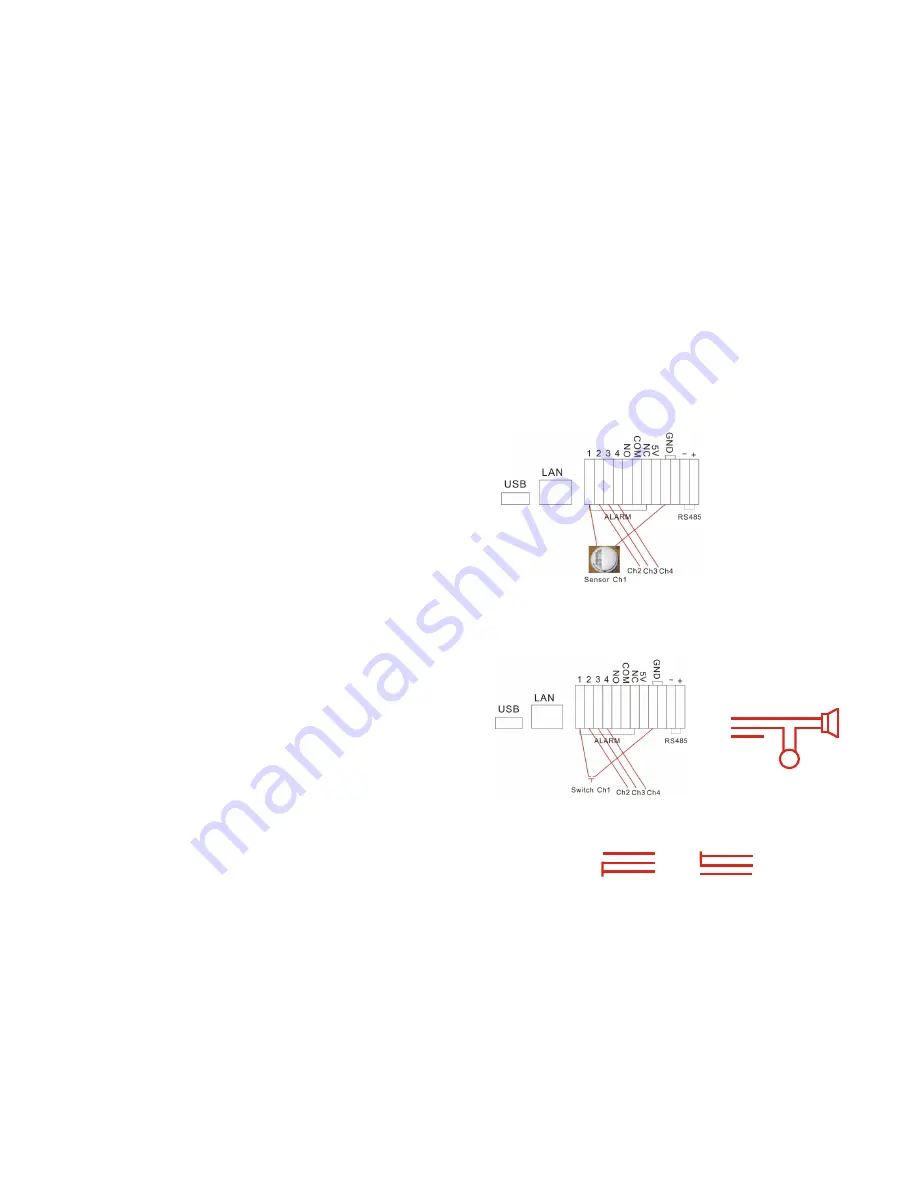
20
23
N
.
O
.
COM
N
.
C
.
N
.
O
.
COM
N
.
C
.
Before
alarm
After
alarm
N
.
O
.
COM
N
.
C
.
Alarm
5V
3.Alarm Connection
The DVR can support up to 4 alarm inputs and three alarm outputs.
Alarm input:
There are two types of alarm input.
1. Voltage output 5V and 0V
A:
If the sensor outputs high voltage (5V) normally and outputs low voltage when triggered
(0V), then users must set DVR for low voltage alarm.
B:
If the sensor outputs low voltage (0V) normally and outputs high voltage when triggered
(5V), then users must set DVR for high voltage alarm.
2. Open/Close output
A: N.O. Normally open/close when triggered. DVR must be set for low voltage alarm.
B: N.C. Normally closed/open when triggered DVR must be set for high voltage alarm.
This diagram shows an example of an
alarm output connection.
Alarm output
There are three alarm output pins, the status of these pins are illustrated as below
If
Schedule mode
is disabled the system will not start recording on alarm. Setting schedule on
or off is achieved through pushing the
SCHEDULE
button on the front panel or remote, but
not through the System Setup menu and window. When the unit is in
Schedule Mode
active,
the character “
S
” will display on the screen. Alarm video recording can’t be stopped by
pushing the
RECORD
or
STOP
button while
Schedule Mode
is active. To ensure that once
Schedule Mode
is set to on that the schedule cannot be accidentally stopped there is a
password protection to stop
Schedule Mode
. You must press the
SCHEDULE
button then
enter the correct password to turn
Schedule Mode
off.
Check
Alarm Recording
setup before recording; confirm the video quality and the frame rate,
as the record setting can’t be changed during the recording process.
As long as the alarm input signal is correctly set the alarm recording will continue during the
period of time set up by
A/M REC TIME
, and when the outside the time period the alarm
recording automatically stops.
5.Time Recording
Time recording starts and stops recording automatically according to the pre-arranged time
period. It is applied to a fixed timetable, for example business hours time recording (or outside
business hours time recording) with fixed start/stop time.
To start the
Time Recording
function you must have a record schedule setup beforehand.
When this is done, push the
SCHEDULE
button on the front panel to set schedule
mode to
on and the schedule symbol “
S
” will display on the screen. The
Time Recording
mode will
not work unless you activate
Schedule Mode
.
To make
Time Recording
mode active the system must be set to
Schedule Mode
active and
that period is set to “
T
” in
Record Schedule
setup.
In Time Record mode, you must push the
SCHEDULE
button then enter the password to
stop time recording.
Because Time recording is reliant on the system being set with the correct time, you must
adjust the time to your correct local time before using this function.
6.Playback
Push the
PLAY
button and the
system will
begin to play the images recorded from the start of
the most current recording.
If the recording is playing, push the
PAUSE
button to pause playing, push the
PLAY
button
again to resume normal play.
To use
Fast Forward
playing or
Fast Backward
playing,
push the
FORWARD
or
REW
button
while the recording is playing to see faster playback. Push the
PLAY
button to return to normal
speed playing from the current place.
Continuous pushing of the
FORWARD
button will change the fast-forward between five levels
of speed (
X2
,
X4
,
X8
,
X16
,
X32
) in sequence. Continuously pushing the
REW
button will
change the fast backward playback between four levels of speed (
X2
,
X4
,
X8
,
X16
) in
sequence.
During playback mode, press the
Single Frame Forward
button to play a frame at a time, and
hold the button in to continually play one frame at time while the button is held.
During playback mode, press the
Single Frame Rewind
button to play back a frame at a time,
and hold the button in to continually play one frame at time while the button is held.
Push the
PLAY
button again to resume normal playback speed, or push the
STOP
button to
stop playing.
















